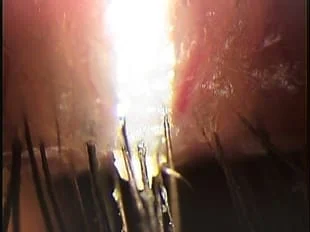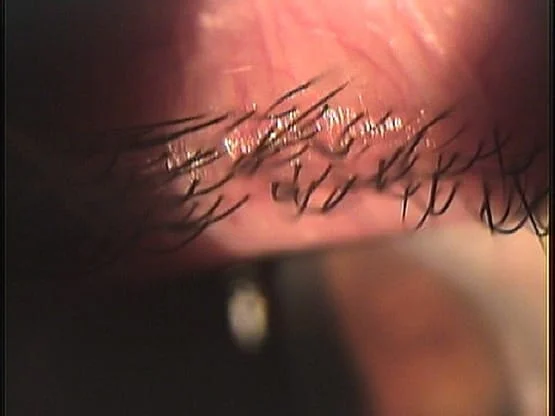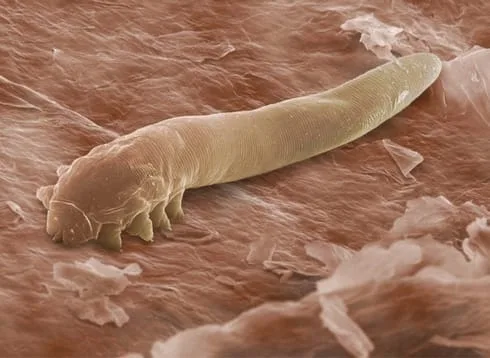Blepharitis
Blepharitis is very common with over 82 million people in the United States with the condition. Symptoms include tired, itchy, burning, or dry eyes.
Blepharitis is an ongoing inflammation (swelling) of the eyelids. The upper and/or lower eyelids become coated with oily particles and bacteria near the base of the eyelashes. This common condition may cause irritation, itchiness, redness, and stinging or burning of the eye. This condition frequently affects people who have a tendency toward oily skin, dandruff, or dry eyes.
Blepharitis Condition
Everyone has bacteria on the surface of their skin, but in some people, bacteria thrive in the skin at the base of the eyelashes. There are two types of blepharitis: Anterior and Posterior. Many people have both anterior and posterior blepharitis at the same time in varying degrees.
Anterior blepharitis affects the outside of the eyelid where your eyelashes are attached. This can be caused by bacterial (or sometimes viral) infection. If left untreated, anterior blepharitis can lead to thickened and inward-turned or outward-turned eyelids and even vision problems from in-turned eyelashes damaging the cornea.
Posterior blepharitis is a condition that results from a dysfunction of the eye's tiny oil glands, meibomian glands, in the eyelids at the base of the eyelashes. When meibomian glands become clogged from posterior blepharitis, it can also cause a stye or chalazion to form. Posterior blepharitis also leads to thickened eyelid margins and crusty eyelids. With this type of blepharitis, tears can even look foamy.
Symptoms
Symptoms include:
- Eye and eyelid irritation
- Foreign body sensation
- Itchiness or scratchiness of the eye
- Redness or inflammation of the eye
- Dry eye
- Burning sensation
- Tearing, crusting, or mattering of the eye
Treatment
Blepharitis is often a chronic, or ongoing, condition, but it can be controlled with the following treatment:
GOOD HYGIENE: Because blepharitis can be an ongoing problem, you should regularly clean your skin and eyelids to keep blepharitis from returning. In addition to carefully cleansing your eyelashes, you can also wash your hair, scalp and eyebrows with antibacterial shampoo to help control blepharitis.
WARM COMPRESSES: Wet a clean washcloth with warm water, wring it out, and place it over your closed eyelids for at least one minute. Repeat two or three times, rewetting the washcloth as it cools. This will loosen scales and debris around your eyelashes. It also helps break down oil from nearby oil glands. This prevents development of a chalazion an enlarged lump caused by clogged oil secretions in the eyelid.
BLEPHEX TREATMENT: BlephEx™ is a painless, in-office procedure which reduces or alleviates the chronic symptoms of blepharitis. Utilizing a handpiece that spins a medical grade micro-sponge along the edge of the eyelids and lashes, the BlephEx™ treatment can remove scurf (flakes on the surface of the skin) and debris while exfoliating the eyelids. This clears the irritating symptoms of blepharitis and improves the overall health of the eyelid allowing patients to begin producing more of their own tears.
BlephEx™ is a relatively new procedure and is not currently covered by insurance. A patient's out-of-pocket expense for the blepharitis procedure is $150 per treatment. Sometimes multiple treatments at 4-6 months intervals are indicated for chronic symptoms.
EYELID SCRUBS: Using a clean washcloth, cotton swab or commercial lint-free pad soaked in warm water, gently scrub the base of your eyelashes for about 15 seconds per eyelid. Our office also carries a easy to use foam cleanser that works great to help keep eyelashes clear.
ANTIBIOTIC OINTMENT: Your ophthalmologist may prescribe an antibiotic ointment. Using a clean fingertip or cotton swab, gently apply a small amount at the base of the eyelashes before bedtime.
Artificial tears or steroid eyedrops may also be prescribed temporarily to relieve dry eye or inflammation. A new antibiotic drop that also helps improve the oil secretions of the meibomian glands may be prescribed by your Eye M.D.
NUTRITIONAL THERAPY: Research suggests that a lack of certain nutrients may contribute to meibomian gland blepharitis. An imbalance of omega fatty acids has been found to cause abnormal secretions of the oil glands that help lubricate your eyes. Ask your ophthalmologist about a proper diet and nutritional supplements to help treat this imbalance.
Article from EyeCare Specialists


Demodex infestation, prior to Blephex cleaning of eye lashes.

After Blephex cleaning is performed. All build up is gone.
Demodex Bug

Demondex
Demodex mites are microscopic eight-legged organisms found primarily in the sebaceous and hair follicle glands of your face. There are two different types of Demodex mites that live on the human body, the Demodex folliculorum and the Demodex brevis. D. folliculorum mites. Both types of Demodex mites have elongated, semi-transparent bodies made up of two fused segments, with the first segment having eight legs attached.
The bodies of both types of Demodex mites are covered in scales that help them attach to your hair follicles. Demodex mites have mouthparts designed to consume skin cells, oil, and hormones found in your hair follicles.
D. folliculorum mites tend to stick around your face, while D. brevis mites tend to migrate to the neck and chest area. A D.folliculorum mite likes to get inside the upper part of a hair follicle and survive on skin cells and oil. D. brevis mites prefer going deep into your sebaceous glands and feeding on the cells.
Treating Demodex
A BlephEx™ treatment is a comfortable in-office procedure using a new patented medical device which employs a high-speed rotating micro-sponge soaked in an eyelid cleanser containing tea tree oil to deep clean and exfoliate your eyelids and eyelashes. This procedure thoroughly removes the debris and other remnants of your demodex mites, while clearing the build up from your eyelids, making it an easy and painless procedure.
Please call our office for more details and/or questions (815) 708-7083.
